Similar Posts
This spring, I received an email from an American client which left me both intrigued and slightly anxious. Would I like to paint a new icon depicting Christ’s interaction with the Rich Young Ruler described in each of the Synoptic Gospels? Yes, of course!
Most icons are commissioned, discussed and then go onto my waiting list. This one would have to be different and would have to jump the queue to be completed in time. Normally I would have said no straight away, but something about this icon and its theme intrigued me. I had heard this story before of course – it is the moment when Christ says “it is easier for a camel to pass through the eye of a needle than for a rich man to enter Heaven”. Like many Christians I was both baffled by the imagery but also struck by a few words in the sentence before, when we hear “Christ looked at the young man and warmed to him”. Does this mean that before this moment, Christ had not felt warmth – or love – for this rich young person? What changed for Christ in that moment that it is marked in the gospel? My client was very clear that THIS was the moment to be shown in the icon – that second when we are told how Christ felt agape for this person who had approached him with such an important question. In our correspondence, he said “The wealthy need a savior too, and they know it. Their spiritual position is precarious even if not their social and logistical position.”
So we had a short length of time, a very particular moment to be shown, and a client who really knew what he wanted this icon to communicate clearly. Not having a prototype to work from was in many ways liberating: we talked directly about the biblical text, reading around the scene and description. My client also brought up a passage from the Hebrew Bible, extremely relevant to this icon:
Deuteronomy 8:11-20: “Moses convened all Israel, and said to them: Take care that you do not forget the Lord your God, by failing to keep his commandments, his ordinances, and his statutes, which I am commanding you today. When you have eaten your fill and have built fine houses and live in them, and when your herds and flocks have multiplied, and your silver and gold is multiplied, and all that you have is multiplied, then do not exalt yourself, forgetting the Lord your God, who brought you out of the land of Egypt, out of the house of slavery, who led you through the great and terrible wilderness, an arid wasteland with poisonous snakes and scorpions. He made water flow for you from flint rock, and fed you in the wilderness with manna that your ancestors did not know, to humble you and to test you, and in the end to do you good. Do not say to yourself, “My power and the might of my own hand have gotten me this wealth.” But remember the Lord your God, for it is he who gives you power to get wealth, so that he may confirm his covenant that he swore to your ancestors, as he is doing today. If you do forget the Lord your God and follow other gods to serve and worship them, I solemnly warn you today that you shall surely perish. Like the nations that the Lord is destroying before you, so shall you perish, because you would not obey the voice of the Lord your God”
I looked at other icons and frescoes of this kind of interaction – Christ meeting the Samaritan Woman, in particular, as we know this story and it is more frequently found in extant examples. Usually Christ is shown sitting while the other person stands, and so this is how I began the sketching out process. I roughly draw out the shape of the board and then do a few ‘brain-storming’ sketches to see what will work best.
Initially I drew the figure of Jesus sitting – traditionally he would sit and the crowd would gather and sit around his feet. However, my client suggested both should be standing – this was a dynamic interaction between Christ and the Young Ruler, rather than a more simple ‘teaching’ scene. As we are told in the Gospel of St Mark:
As He was setting out on a journey, a man ran up to Him and knelt before Him, and asked Him, “Good Teacher, what shall I do to inherit eternal life?” And Jesus said to him, “Why do you call me good? No one is good except God alone. You know the commandments, ‘Do not murder, Do not commit adultery, Do not steal, Do not bear false witness, Do not defraud, Honor your father and mother.’” And he said to Him, “Teacher, I have kept all these things from my youth up.” Looking at him, Jesus felt a love for him and said to him, “One thing you lack: go and sell all you possess and give to the poor, and you will have treasure in heaven; and come, follow Me.” But at these words he was saddened, and he went away grieving, for he was one who owned much property.
And Jesus, looking around, said to His disciples, “How hard it will be for those who are wealthy to enter the kingdom of God!” The disciples were amazed at His words. But Jesus answered again and said to them, “Children, how hard it is to enter the kingdom of God! It is easier for a camel to go through the eye of a needle than for a rich man to enter the kingdom of God.” They were even more astonished and said to Him, “Then who can be saved?” Looking at them, Jesus said, “With man it is impossible, but not with God; for all things are possible with God.”
Christ is ever so slightly taller, as He is mature in body and of course His Divine Nature. He is clothed traditionally, with the red robe of His human nature adorned by the blue outer garment of His Divinity. He is shown with a clear, compassionate expression – with His right hand He blesses and I chose that His left hand should be open, extending towards this young man who has come seeking His teaching on life and how to be saved. It is not a begging, not a pleading – it is an open, loving invitation to the young man (and all of us). “Here, take my hand, and I will lead you into Paradise”. He is shown not quite standing, not quite moving – Christ was about to leave at the end of a long time answering, telling parables, teaching. Yet He hesitates, having heard the direct question and honest response of this wealthy young man.
The Young Ruler is, obviously, dressed very differently. My client and I discussed at length how we could show his material prosperity and how that should be illustrated. Garish colours? Gold and jewels? Furs even? It was very tempting to have some real ‘fun’ with this ensemble, to communicate just how extravagant his wealthy behaviour had become. And yet there is nothing intrinsically wrong with his wealth – it is a fact of his life, like brown hair or a straight nose. I felt that although he was rich, he was not intrinsically ‘bad’ or even tasteless in the way that using artificial pigments might convey.
Here, a technical side note. The pigments that I use are always natural ones. They are formed out of the earth, metals, stones, even a precious gem or two, and ground up to be mixed with the yolk of eggs (from my garden hens) and water, with a little vodka. They have a quality and a life that is conveyed, imperceptibly, to our brain. I noticed one morning that as I sat down to work, the sunlight caught little tiny sparkles on the paint surface – minute stars, glimmering in the blue of Christ’s robe, as the azurite is particularly prone to this grainy quality (if too finely ground it will lose its colour). This means that the light not only penetrates through the layers of paint, onto the white of the gessoed board to reflect back at us the layers of colour, but that the light is being refracted and almost behaving in that chaotic, swirling way that reminds me of the waters before Creation – they are full of movement but not in a regular form. This is why acrylic paint and artificial pigments do not fulfill the full liturgical, doxological, eucharistic theology of iconography – they can be unutterably beautiful and God may grant His Grace to work through them of course – but there is a reality in the very matter used in icons. I am so grateful that my client understood all of this because my next step was not what we had discussed at all.
I sat down and gazed at the form of the young man. I had spent hours drawing him, over and over, until I got the combination of supplication, enquiry and so on, combined with the transformed nature of the icon as right as I could. I knew that I wanted him to be bright. Yet as I sat there, I knew that, underneath the almost turquoise terre verte I wanted for his robe, there must also be a deep layer of azurite – the same as Christ’s robe. Here was a young man who wants to be saved, who wants to be with Christ – and yet he already is with Christ, and he already partakes of that Divinity in his person by virtue of being human and therefore already formed in God’s likeness and image. I had to find a way to show that all humanity, whether rich or poor, is a part of God’s likeness and that his wealth was no bar to this – if only he (and we) can recognise it. This led to a slightly different choice for his cloak – the inner red, which grabs our attention here, and on his delicately shod feet is a genuine (and poisonous) vermillion. This is the most intense colour I ever use and it certainly grabs attention. Who other than a very rich person would travel with such impractical, highly decorative garments? His shoes illustrate that he does not have to walk for miles; he rides a fine horse or is perhaps carried on a litter. His cloak is sewn with pearls and yet they would not help protect him from weather; this is all about displaying status, like designer labels in our day perhaps. His hem and crown are both gold, as is the decorative panel on his cloak. However, you might be wondering why I didn’t use real gold, as there is lots of gold leaf on the background of the panel.
Gold, in an icon, is not used to depict the metal gold on this earth (or not solely that). In this instance, the gold in background is a 23 ½ carat gold leaf, double layered over a red clay base. As simply put as possible, the gold is the presence of the unseen God “in whom we live and move and have our being”. He is closer to us than our own breath and yet cannot be seen with eyes. This gold is a reminder of that presence and part of the ‘transfigured reality’ that icons show us. When gold is used on a garment, it is not to show itself but the light of divinity transforming material, fabric, garments, just as Christ’s robes were transfigured on Mt Tabor; the Light of God transforms the very matter around us as far as we are able to see it. So the lines of gold on the robe of the Virgin Mary, the lines of gold on the robe of an infant Christ etc., all are signs of the indwelling of God possible within His good creation when it is transmuted by His presence and in the fullness of its potential reality.
The crown, hem and cloak are therefore painted with a bright Italian yellow ochre to illustrate the decorative nature of his garments but not their essence. They are finely figured in the Byzantine style of the 12th-13th centuries and, I hope, communicate how wealthy this person would have been to wear such finery.
As he reaches towards Christ in supplication, there are other tiny elements which tell us both where the icon was made and where it is going: in the sea-green of the young ruler’s robes, my client saw a hint of the Scottish sea in summer; in his crown, there are faceted sapphires which suggest the saltire flag, the cross of St Andrew. At his feet, we can see the Colorado Ground Snake (sonora semiannulata) and scorpion, species native my client’s home, and which call to mind the passage in Deuteronomy. Behind Christ, there is in the distance a waterfall – He is the life-giving water which not only quenches all who thirst but is so essential for life in the hot, desert country where this icon will live. Around Christ’s feet, there are a few native plants from the Colorado region as well – Columbine, blanket flower and a reference to Christ as the vine.
There is also an element of ‘sacred geometry’ involved. Between the figures, one can see the shape of a chalice. There is a Communion taking place between Christ and this rich young ruler, similar to the Eucharist celebrated daily in churches throughout the world. A similar chalice shape exists in the Rublev Holy Trinity, which I was studying at the time.
I was sad to complete this icon. I am always reluctant to let them go, having been blessed by spending so many hours in prayer with them and getting to know the Saints or the passage of the Gospel in this case. But I am more delighted than I can say to know that it is going to be shared with so many who wish to bring the Gospel and good news of Christ’s love to more in the community and that it will be so well cared for, and prayed with. I should perhaps say I feel sad, but also immensely blessed.

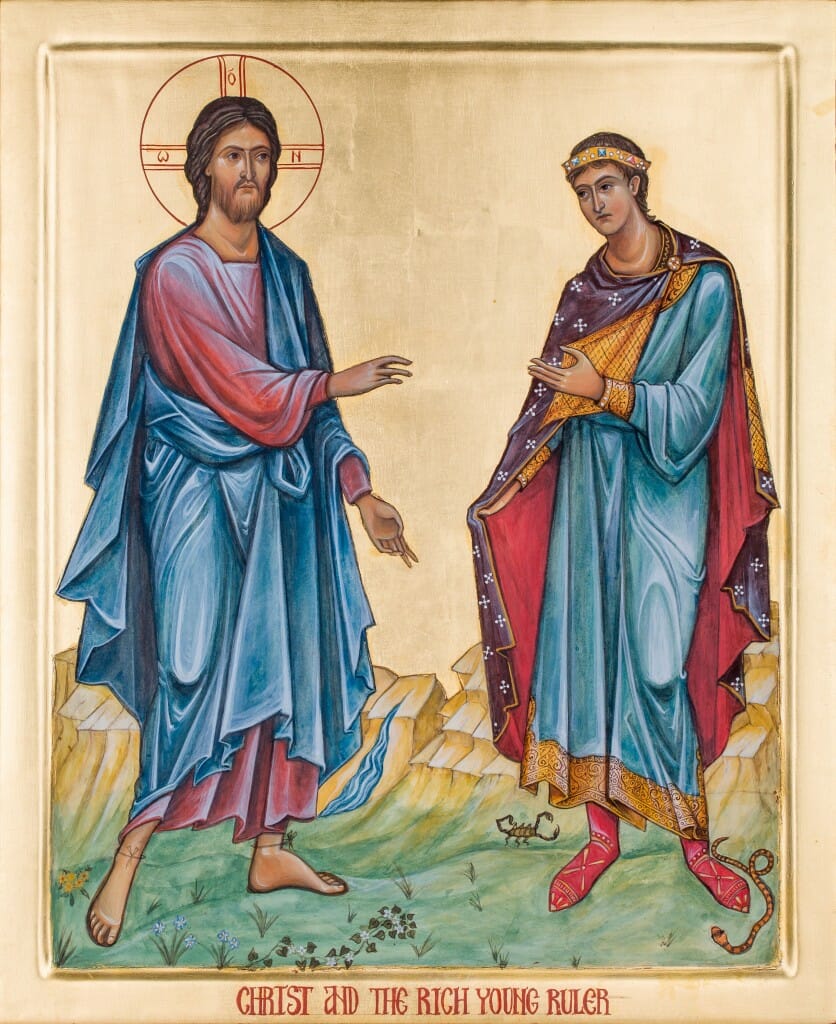

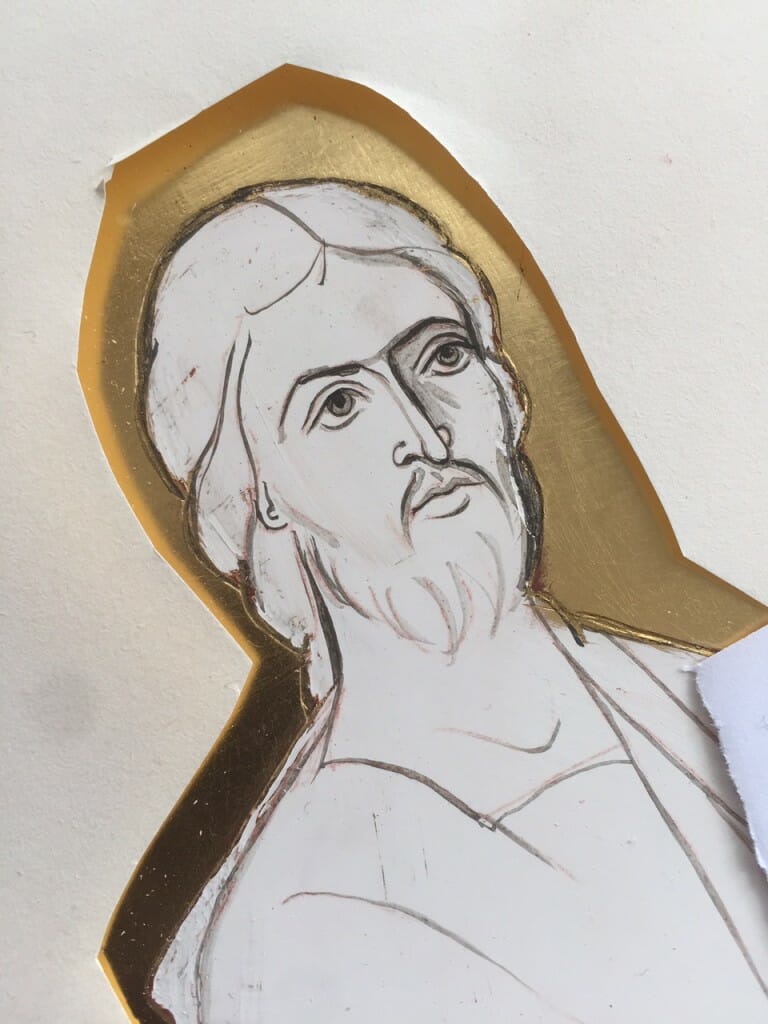
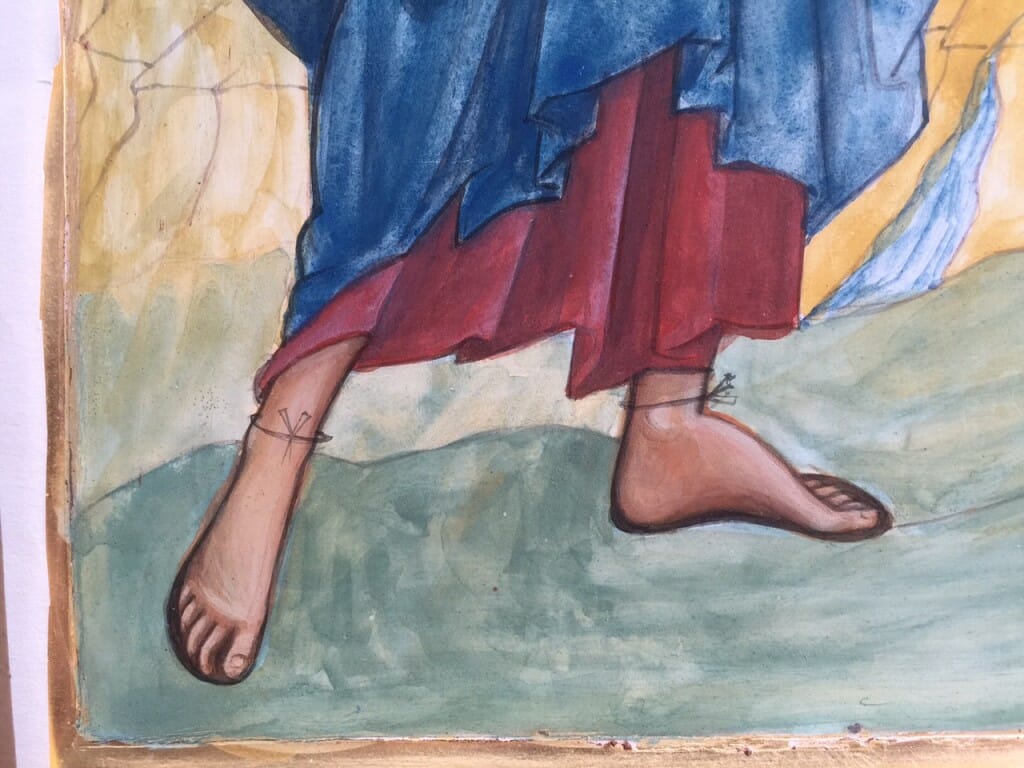
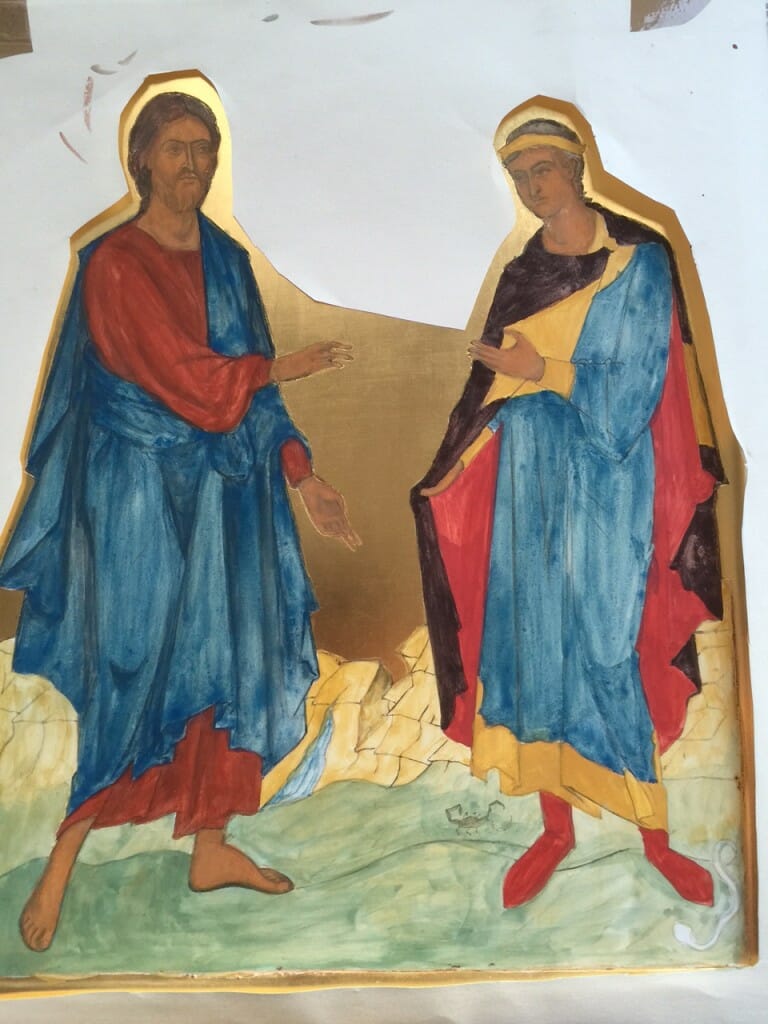
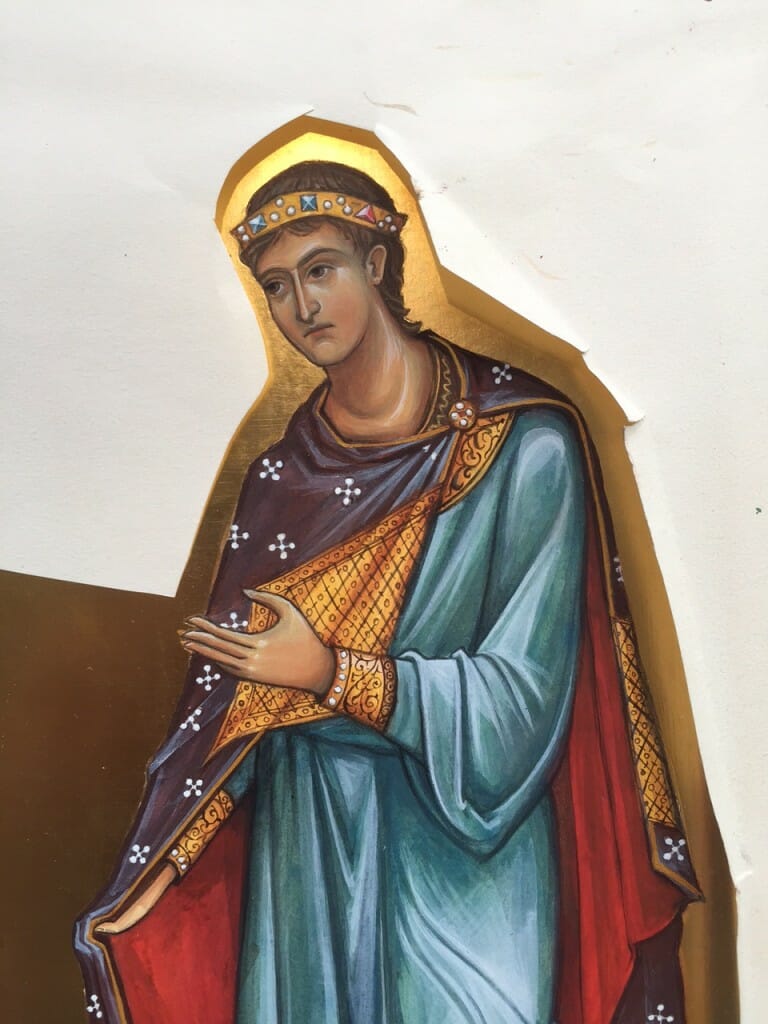
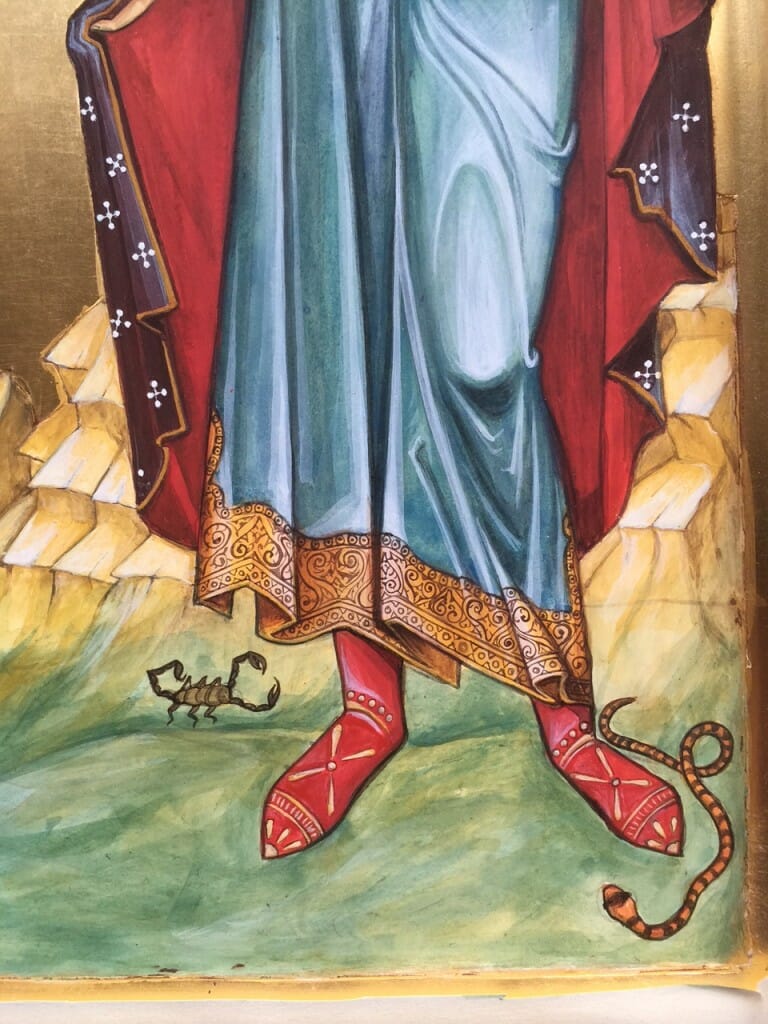
Thank you so very much for this insight into your process. The icon is extraordinary in that it conveys through the icon form such a range of subtlety and Spirit. Very beautiful and moving icon. Both he figure of Christ and the Young Ruler convey such a depth of feeling and Inspiration.
Thank you Anne, I’m so glad you liked it.
A wonderful and unusual icon and wonderful words.
Thank you Laura, I really appreciate your thoughtful words.
[…] For the complete article “A New Icon Composition: Christ and the Rich Young Ruler” by Katherine Sanders • October 9, 2015 • Orthodox Arts Journal go to https://orthodoxartsjournal.org/a-new-icon-composition-christ-and-the-rich-young-ruler/ […]
It is very a beautiful and much thought icon! One observation: in true Byzantine icons only the saints were painted with red shoes. It was the symbol of their holiness.
In Byzantine society red shoes were reserved for the ruling class. They were a sign of high authority. In Byzantine mosaics, emperors wear red shoes whether or not they were sainted. When saints are depicted with red shoes it is to show divine authority, not holiness. The contrast of shoes in this icon is appropriate – Christ’s sandals showing ascetic holiness and freedom to walk anywhere, the young man’s tight-fitting red shoes showing how his body is trapped in his role as a rich aristocrat.
Thank you Angela, I’m glad you liked it. As Andrew says, the red here is a symbol of earthly wealth and his secular power: but it binds him to the earth, to this world and that is why he is sad when Christ asks him to give away all he has. I suspect it is a common reaction! I also wanted to emphasis the freedom that comes from not being bound by worldly standards of beauty and elegance: Christ is Himself completely unadorned and yet He is far more powerful in that very humility and emptiness.
fascinating and edifying. Thank you so much.
Thank you Fr Stephen!
This is a beautiful icon, and I enjoyed learning of your detailed thought processes that went into the making of it. Thank you for sharing your seen and unseen talents so generously with us.
Katherine, how much richer this familiar story has become through your beautiful, thoughtful and prayerful depiction, and how intimately we are drawn into the scene, witnesses of Christ’s loving invitation and the disappointment in the rich young ruler’s countenance. I am blessed in your sharing this icon and know that others will be blessed as I share with them.
Thank you so much for the wonderful explanation!
I have been musing over a question that pehaps you could give me some insight on: could you please let me know your thoughts on the appropriateness (or lack, as the case may be) of “modern clothing” in icons? Or even period clothing, that is not neo-Byzantine/religious garb/one of the styles commonly seen? I have occasionally (in the case of Asian saints) seen other forms of clothing…but modern, Western styles don’t seem to quite ‘fit’ yet I don’t know why….or whether this is simply a case of unfamiliarity, since most icons have saints who lived in earlier ages.
Cheers Katherine,
Very nice icon. I wonder if you ever considered reversing which side Christ and the Young Ruler are on? In your composition it looks to my eye (Western, non-dyslexic who reads from left to right) that Christ is traveling towards the young man to meet him. For those of you who have photoshop or a similar program, you can try flipping the image horizontally and discover that it changes the dynamic quite a bit, adding some desired meaning if you ask me. When rather the ruler is on the left side of the composition (source) he is the one traveling towards Christ, but you can see from his body language that he is not fully engaged, and he never reaches Christ even though Christ awaits with outstretched hands on the right side of the composition (destination). You can see even in this encounter a foreshadowing of the rulers return back out of the left side of the frame to where he came from because Christ presents a barrier, a stumbling block in the man’s progress (right-ward movement). Anyway, just an interesting thought for y’all.
Something I like about the way you did the drapery is that Christ’s falls away from his outer side with more angular energy as if he’s approaching the young man. Whereas the young ruler’s cloak tips off his outer shoulder with limp inaction but actually that first fold almost seems to be magnetically drawn towards the outer frame of the picture, as if his cloak itself is still magnetically attracted to the world and would rather not be in the presence of Christ.
with your prayers,
baker
Dear Katheryn, this is a beautiful icon and very well done technically. thank you for taking the time for explaining the thought process behind all the details. one item i noticed is that the red clothing is taught as the color of humanity and blue as heavenly. as a personal choice i would have dressed the rich young man in reds, similar to the Theotokos, with maybe a stain on his outer garment to show the active sin. also Christ has his left hand offering a Blessing. i would have lifted that up to place higher up closer to the young man’s shoulder. the last recommendation was from the quote, “camel into the eye of a needle”. i would have considered having a small camel caravan walking away in the distance. All humble suggestions as you have done a remarkable representation of the scripture, especially where you had nothing to follow. Congratulations! in Christ, Cherie